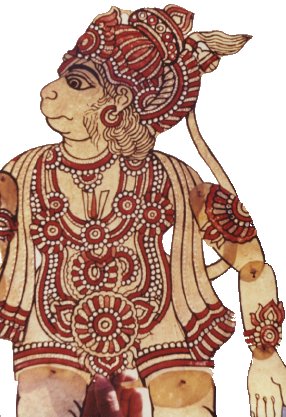Leather Puppets of India
by K.L. Kamat
First created: April 19, 1999
Last updated: December 07, 2024
The arrival of the puppeteers' team to an Indian village is welcome news to young and old villagers alike. The artists belong to a nomadic tribe of Gypsies and hence are always on the move. They carry their own baggage, which consists of huge leather bags containing puppets, musical instruments and a few utensils. They pitch a homemade, moderate-sized tent under a tree and commence their activities. The head approaches the village elder and seeks permission, monetary help and food for performing his show, which are always granted.

Leather puppet of Hanuman, the monkey
Many of India's puppets are based on the Hindu mythologies. Here, see the delicate work on
a puppet of Hanuman.
In no time, the team sets up a rectangular stage by using split bamboo stems and woolen blankets (kambali). In front of this four sq. meter enclosure, a white semi-transparent cloth is used as a backdrop to project the puppets. Just behind the screen runs a rope from which the puppets are hung. In order to project the puppets on the screen a bright oil lamp is placed behind them. The entire family is posted behind the stage and participates in different activities of the show.

A puppeteer performs
The performance starts with an invocation to Lord Ganesh (the elephant headed Hindu god, who banishes all troubles) and Saraswati (the Goddess of learning.) In order to announce the beginning of the show, a pair of clowns Silekyatha and his hilarious wife Bangarekka make an appearance on the screen. They attract the audience by making indecent observations, gestures, jokes and comments on village affairs. The core of the performance is then enacted, during which are presented detailed and dramatically prolonged episodes from the Ramayana, the Mahabharata, stories from the Puranas and the Devi scriptures. The male, female, and children’s voices are provided by the head-puppeteer, his wife and children respectively. Music is provided by either rubbing a reed on the back of a bell-metal dish, by a mukha-veena or by a harmonium. The visuals are synchronized with music. The experts in the family control the movements of puppets by employing strings and chords attached to them. Hence, their puppets can walk, talk, dance, gesticulate, and even drop dead! The performances commence late at night and are continued till dawn. Then the troupe goes around the village and collects food, clothes, and coins.
|
|
Besides entertainment, the performances have ritualistic significance too. The puppeteers are invited to different villages throughout the year. They are requested to perform in order to bring in good rains, fertility to the soil, and excellent crops. When cattle herds are struck by disease, the puppeteers are once again invited. They also receive special invitations on happy occasions such as birthdays and weddings. Puppeteers are not forgotten when deaths occur in the village. The themes of the puppet plays depend on the occasions for which they are invited. For instance, they perform "Krishna Leela" (the antics of Krishna) on birthdays, "Girija Kalyana" (the wedding of Girija) on a wedding day or "Swargarohana" (ascent to heaven) in the event of a death.
Puppeteers' leather dolls are masterpieces of folk-art. Usually deer skin and goat hide are used, as they can be rendered transparent. They easily absorb different colors and can last for centuries. However the hides of buffaloes, donkeys, and camels may also be employed for the same purpose. The raw hide is first treated with a solution of common salt or caustic soda and dried. Then it is painted with deep colors extracted from locally available plants and rocks. Different parts of a doll are obtained from various hides and are joined in such a way that their limbs and head can be moved with ease. For this purpose, various parts of each puppet are connected with strong strings and thin sticks, with the help of which their movements are controlled. These dolls are manufactured either by the puppeteers themselves, or through a professional artist. At times, the villagers have the puppets made, inscribe their ancestors' names in them, and donate them to the troupe. The dolls are stored and carried in a leather box and periodically worshiped. The more orthodox among the villagers believe that on the new moon and the full moon days these puppets come to life and perform by themselves inside the box.
This art form is at least a thousand years old. From India, it went to southeast Asia and Turkey. Now it is prevalent only in the south Indian states. In recent times this art came to Karnataka state through its organizer, Kattare Kalachari, who hailed from Maharashtra state. These puppeteers are also known by different names such as Killekyathru in Kannada, Chitra Marathigaru in Marathi, Tolu Bomlat in Telugu, and Pavaikottu in Malayalam. In Karnataka State (map, topics) there are several families which perform in their local areas, and are known by distinct names such as Gomberama Chakkai Gobbeyata, Togalu Gobbeyata, etc.

A Leather Puppet of Mahatma Gandhi
The future for the puppeteers is very bleak. Today’s villagers are attracted to movies and television shows. Hence many puppeteer families have taken to agriculture and some have been forced to work as farm hands. However, their leather puppets are in great demand in western countries, and the middleman pockets large sums of money by selling them. Thus, the puppeteers are denied the much-deserved fruits of their labor.
See Also:

The puppets are made with leather and then painted. The movements are controlled by
threads and sticks.
